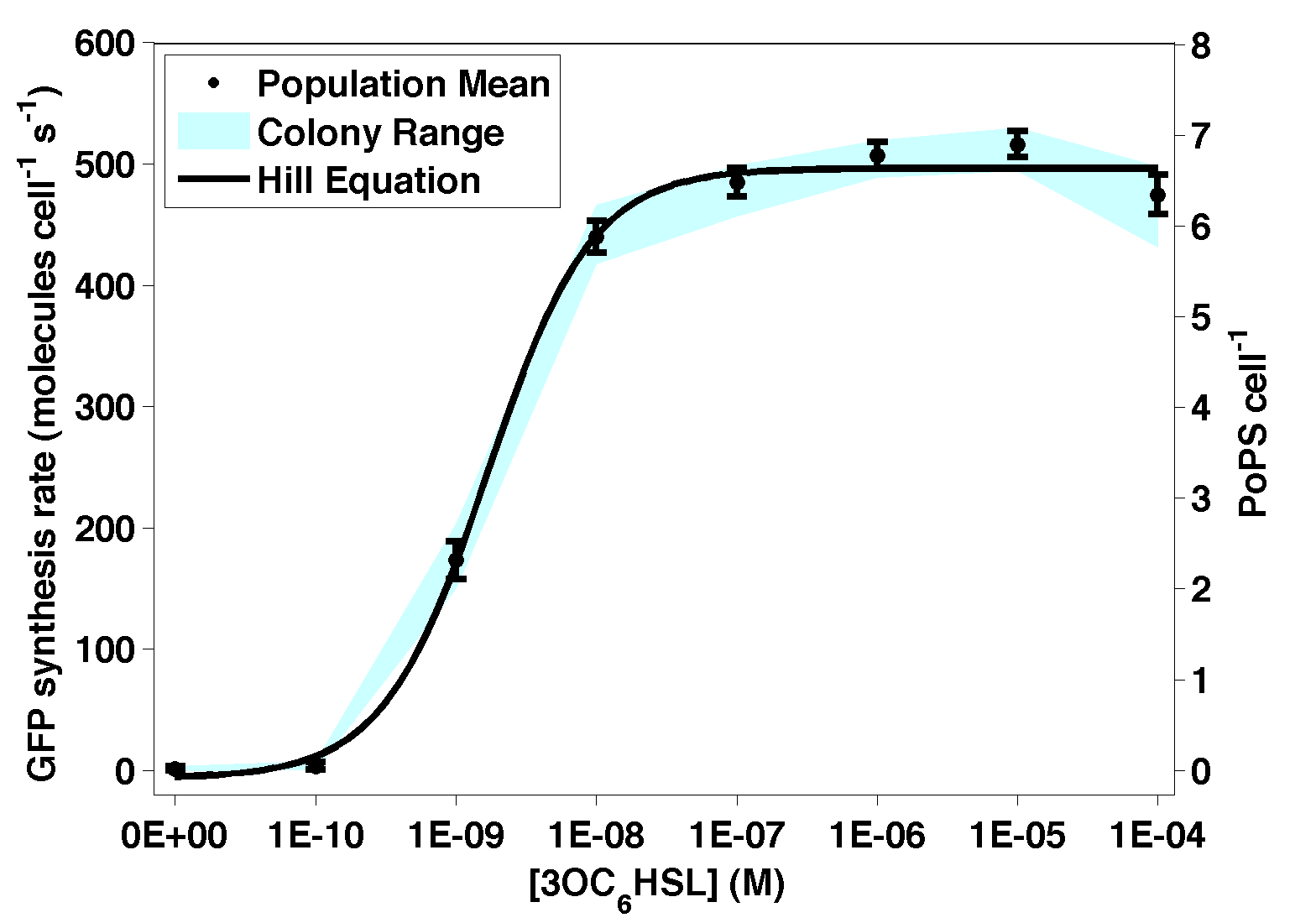Difference between revisions of "Part:BBa K325219:ArabinosetoLight"
(New page: <div style="font-family: Arial; padding: 00px; width: 680px; border: 0px solid #000000;"> {{Template:K325219 page header}} {{Template:K325219 Characterization Navbar}} <div style="padding:...) |
|||
| Line 4: | Line 4: | ||
<div style="padding: 00px; width: 680px; border: 0px solid #000000;"> | <div style="padding: 00px; width: 680px; border: 0px solid #000000;"> | ||
'''Description'''<br> | '''Description'''<br> | ||
| − | This | + | |
| − | + | This page describes the relationship between Arabinose concentration in the medium with light output. | |
| + | |||
| + | ==Data== | ||
| + | |||
| + | [[Image:BBa F2620TransferFunctionOct07.png|thumb|569px|center|'''Figure 1 - Transfer function of <partinfo>F2620</partinfo>. The data points represent the mean of 6 or 9 individual measurements. The corresponding error bars represent the 95% confidence interval in the mean of the independent measurements. The blue shaded region represents the range bounded by the lowest and highest outputs among the independent measurements at a given input level. The solid black curve was calculated by fitting a simple Hill function to the experimental measurements.''']] | ||
Revision as of 14:05, 24 September 2010
|
|

|
Description
This page describes the relationship between Arabinose concentration in the medium with light output.
Data

Figure 1 - Transfer function of BBa_F2620. The data points represent the mean of 6 or 9 individual measurements. The corresponding error bars represent the 95% confidence interval in the mean of the independent measurements. The blue shaded region represents the range bounded by the lowest and highest outputs among the independent measurements at a given input level. The solid black curve was calculated by fitting a simple Hill function to the experimental measurements.
Performance
| Experiment1 | Characteristic1 | Value1 |
|---|---|---|
| Transfer Function | Maximum Output | 6.6 PoPS cell-1 |
| Hill coefficient | 1.6 | |
| Switch Point | 1.5E-9 M 3OC6HSL, exogenous | |
| Response time: | <1 min | |
| Input compatibility | Strong response to | 3OC6HSL, C6HSL , C7HSL, 3OC8HSL, C8HSL |
| Weak response to | C4HSL, C10HSL, C12HSL | |
| Stability | Genetic Stability (Low/High Input) |
>92/>56 generations |
| Performance Stability (Low/High Input) |
>92/>56 generations | |
| Demand | Internal Demand (Low/High Input) |
Not measured |
| Transcriptional output demand: (Low/High Input) Nt = length of downstream transcript in nucleotides |
(0/6xNt) nucleotides cell-1 s-1 | |
| (0/1.5E-1xNt) RNAP cell-1 | ||
| Growth Rate (Low/High Input) |
54/59 min Doubling time |
1Measured by the [http://2010.igem.org/Team:Cambridge Cambridge iGEM team 2010]
Compatibility
Chassis: Device has been shown to work in Top 10 (Invitrogen)
Plasmids: Device has been shown to work on pSB1C3
References
[http://www.ncbi.nlm.nih.gov/pubmed/18949818 [1]:] S.M. Marques and J.C.G. Esteves da Silva, (2009) Firefly Bioluminescence: A Mechanistic Approach of Luciferase Catalyzed Reactions,Life 61, 6-17.
[http://www.nature.com/nature/journal/v440/n7082/abs/nature04542.html [2]:] T. Nakatsu et al. (2006) Structural Basis for the spectral difference in luciferase bioluminescence, Nature 440(16), 372-376.
[http://www.ncbi.nlm.nih.gov/pubmed/11457857 [3]:] K. Gomi and N. Kajiyama, (2001) Oxyluciferin, a Luminescence Product of Firefly Luciferase, Is Enzymatically Regenerated into Luciferin, The Journal of Biological Chemistry, 276(39), 36508-36513.